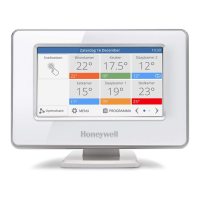ENGINEERING MANUAL OF AUTOMATIC CONTROL
VALVE SELECTION AND SIZING
433
Linear: A valve which provides a flow-to-lift relationship that
is directly proportional. It provides equal flow changes
for equal lift changes, regardless of percentage of valve
opening.
Quick-opening: A valve which provides maximum possible
flow as soon as the stem lifts the disc from the valve
seat.
Valve flow characteristic: The relationship between the stem
travel of a valve, expressed in percent of travel, and
the fluid flow through the valve, expressed in percent
of full flow.
VALVE FLOW TERMS
Rangeability: The ratio of maximum flow to minimum
controllable flow. Approximate rangeability ratios are
50 to 1 for V-port globe valves and 30 to 1 for
contoured plug valves.
EXAMPLE:
A valve with a total flow capacity of 100
gpm full open and a rangeability of 30 to 1,
can accurately controls flow accurately as
low as 3 gpm.
Tight shut-off/close-off: A valve condition in which virtually
no leakage of the controlled fluid occurs in the closed
position. Generally, only single-seated valves provide
tight shut-off. Double-seated valves typically have a
one to three percent leakage in the closed position.
Turndown: The ratio of maximum flow to minimum
controllable flow of a valve installed in a system.
Turndown is equal to or less than rangeability.
EXAMPLE:
For the valve in the rangeability example,
if the system requires a 66 gpm maximum
flow through the valve and since the
minimum accurately controllable flow is
3 gpm, the turndown is 22.
VALVE RATINGS
Flow coefficient (capacity index): Used to state the flow
capacity of a control valve for specified conditions.
Currently, in the control valve industry, one of three
flow coefficients British Av, North American Kv, or
United States C
v
is used depending upon the location
and system of units. The flow coefficients have the
following relationships:
A
v
=0.0000278 K
v
A
v
=0.0000240 C
v
K
v
=0.865 C
v
The flow coefficient Av is in cubic meters per second
and can be determined from the formula:
Where:
Q=volumetric flow in cubic meters per
second.
ρ = fluid density in kilograms per cubic
meter.
∆p=static pressure loss across the valve in
pascals.
The flow coefficient Kv is water flow in cubic meters per
hour with a static pressure loss across the valve of 10
5
pascals (1 bar) within the temperature range of 5 to
40°C and can be determined from the formula:
Where:
Q=volumetric flow in cubic meters per hour.
ρ = fluid density in kilograms per cubic
meter.
ρ
w
= density of water in kilograms per cubic
meter.
∆p
Kv
= static pressure loss of 10
5
pascals.
∆p=static pressure loss across the valve in
pascals.
The flow coefficient C
v
is water flow in gallons per
minute with a pressure loss across the valve of one
pound per square inch within the temperature range
of 40 to 100F and can be determined for other
conditions from the formula:
Where:
Q=volumetric flow in US gallons per
minute.
ρ = fluid density in pounds per cubic foot.
ρ
w
= density of water in pounds per cubic foot
within the temperature range of 40
to 100F
∆p=static pressure loss across the valve in
pounds per square inch.
Close-off rating: The maximum pressure drop that a valve can
withstand without leakage while in the full closed
position. The close-off rating is a function of actuator
power to hold the valve closed against pressure drop,
but structural parts such as the stem can be the limiting
factor.
A
v
= Q
ρ
∆
K
v
= Q
∆ρ
K
v
∆p
•
ρ
ρ
C
v
= Q
1
∆p
•
ρ
ρ

